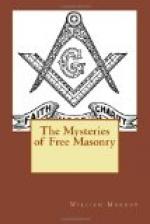Q. Why is the triangle, with the word secret on it, considered as the most precious jewel in Masonry? A. Because by its justness, equality, and proportion, it represents our redemption.
Q. By what mark was the place discovered where Hiram Abiff was buried by his assassins? A. By a sprig of cassia (say granate).
Q. For what reason do the Master Masons in the Symbolic Lodges speak of a sprig of cassia? A. Because the Sublime Grand Elected descendants of the ancient Patriarchs did not think proper to give the real name or truth of Masonry; therefore, they agreed to say that it was a sprig of cassia, because it had a strong smell.
Q. What are the reasons for the different knocks at the door to gain admittance? A. To know and be assured that they have passed the different degrees, which number we must understand.
Q. For what reasons do we keep our mysteries with such circumspection and secrecy? A. For fear there might be found amongst us some traitorous villains similar to the three Fellow Crafts who murdered our chief, Hiram Abiff.
Q. What is the reason that the Grand Masters of all Lodges are received with so much honor in the Symbolic Lodges? A. Those homages are due to their virtues as Princes of Masons, whose firmness has been shown on so many occasions, by spilling their blood in support of Masonry and the fraternity.
Q. Why do we applaud with our hands? A. In that manner we express our happiness and satisfaction at having done a good action, and rendered justice.
Q. What reflections occur, when contemplating the conduct of Solomon? A. That a wise man may err, and when he is sensible of his fault, correct himself by acknowledging that fault, whereby he claims the indulgence of his brethren.
Q. Why do the Symbolic Lodges take the name of St. John of Jerusalem? A. Because in the time of the Crusades, the Perfect Masons, Knights, and Princes, communicated their mysteries to the Knights of that order; whereupon it was determined to celebrate their festival annually, on St. John’s day, being under the same law.
Q. Who was the first architect that conducted the works of Solomon’s temple? A. Hiram Abiff; which signifies the inspired man.
Q. Who laid the first stone? A. Solomon cut and laid the first stone, which afterwards supported the temple.
Q. Was there anything enclosed in that stone? A. Yes; some characters, which were, like the name of the Grand Architect of the Universe, only known to Solomon.
Q. What stone was it? A. An agate of a foot square.
Q. What was the form of it? A. Cubical.
Q. At what time of the day was the stone laid? A. Before sunrise.
Q. For what reason? A. To show that we must begin early and work with vigilance and assiduity.
Q. What cement did he make use of? A. A cement which was composed of the finest and purest flour, milk, oil, and wine.




